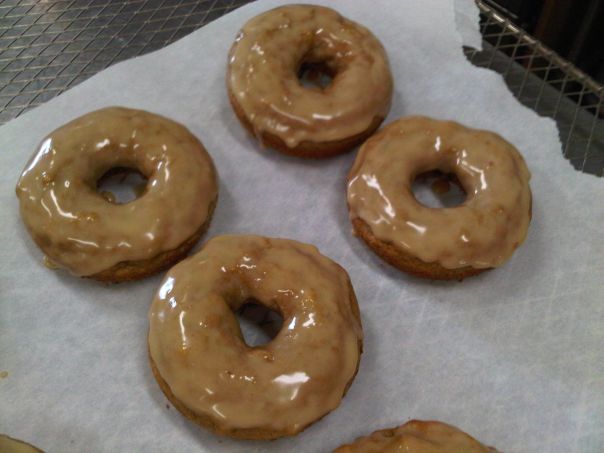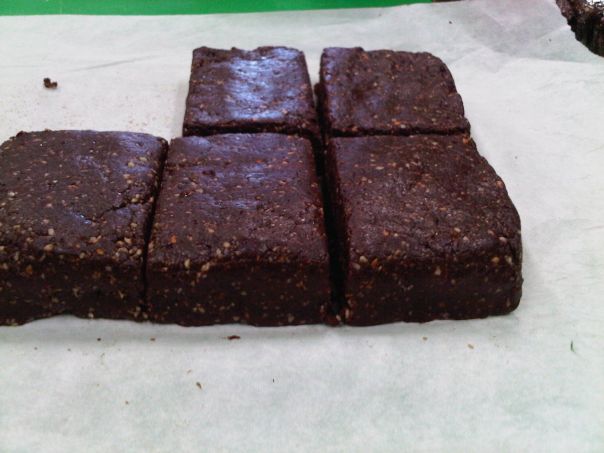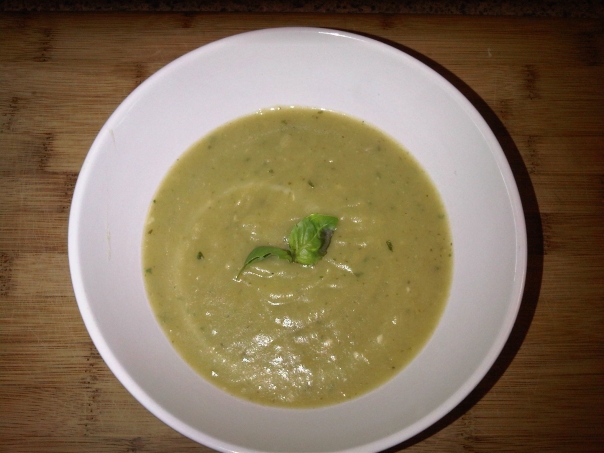Research: Beet Root Juice Showing Protection Against Cardiovascular Disease
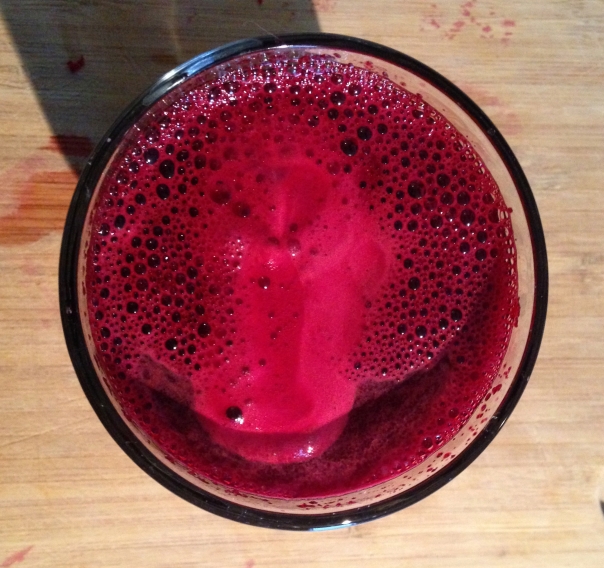
In a recent study out of the UK published in the American Journal of Clinical Nutrition on patients with high cholesterol, beet root juice was found to significantly improve vascular function. The study was a randomized, double-blinded, and placebo-controlled involving over 65 participants drinking 250 mL of beet root juice every day for 6 weeks. Beet root juice is a rich source of dietary nitrate which can be converted to nitric oxide (NO) in the body via bacteria in the mouth and enzymes in the body. NO is known to be protective in cardiovascular disease (CVD) through its action of dilating blood vessels, reducing inflammation, reducing clotting, and reducing cell proliferation. What is most interesting is that it was found in this study to have additional protective effects by improving vascular function, or in other words it was found to significantly reduce the progression of CVD in an at risk group of people by improving the flow of blood through the vascular system. Quite significant improvements were seen from only a month and a half of drinking beet root juice daily. This may be an excellent strategy in the prevention of CVD as it is safe, well-tolerated, and quite effective. You can read more about this study here: http://ajcn.nutrition.org/content/103/1/25.short
Beets are excellent vegetables for juicing. They are relatively inexpensive, shelf stable, and yield quite a lot of juice in comparison to other veggies. They also make quite a beautiful looking juice with a bright magenta colour. Chef’s tip: wear rubber gloves when you are peeling and chopping your beets to prevent the skin on your hands from staining. Also, I like to put a few layers of paper towel on my cutting board to prevent staining there as well (especially if you are using porous, or wooden cutting boards).
If you are new to juicing, it’s good to juice cold vegetables. I find the juice more palatable when it is nice and cold. I also like to mix other fruits and vegetables in a juice to give it some character. Carrots, celery, apples, and cucumber are excellent for juicing as they also have a high juice yield. Another helpful tip is to take the pulp after juicing your veggies and put it through the juicer again to get the most out of the vegetables you’re using. If you want to take a little step further, I like to blend fresh juice with leafy greens such as spinach, parsley, or collard greens in a blender to add even more nutrition. Blend in a couple table spoons of chia seeds and you’ve got a nutrient and fibre-packed super juice ready to combat CVD!
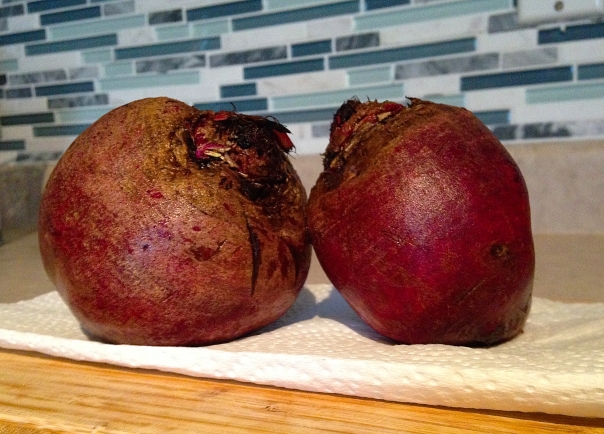
1. Wash beets
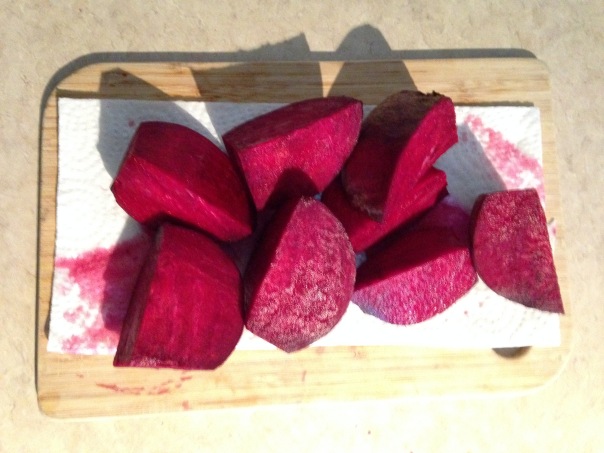
2. Cut off tops, and cut into pieces that will fit your juicer
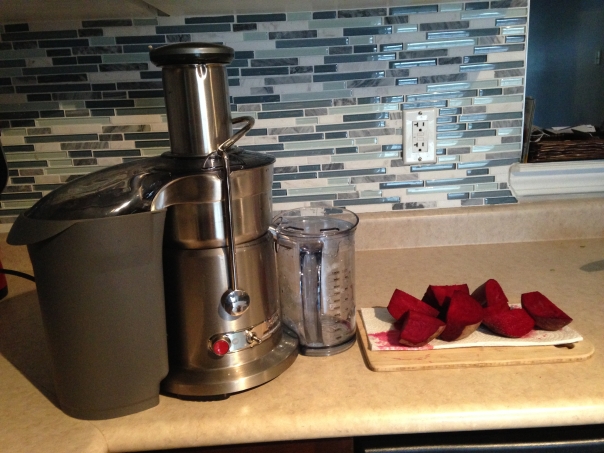
3. Juice
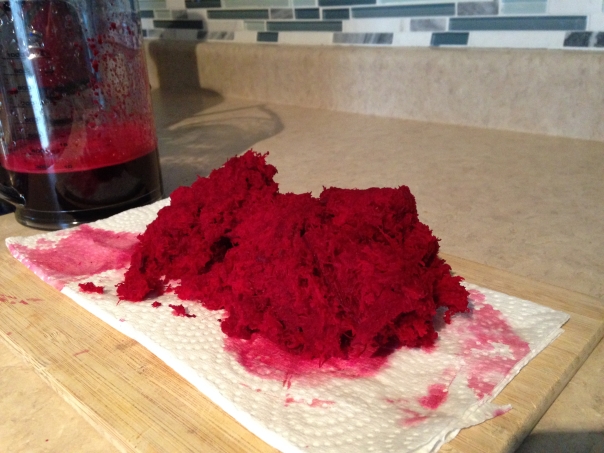
4. Take the pulp, and juice it again
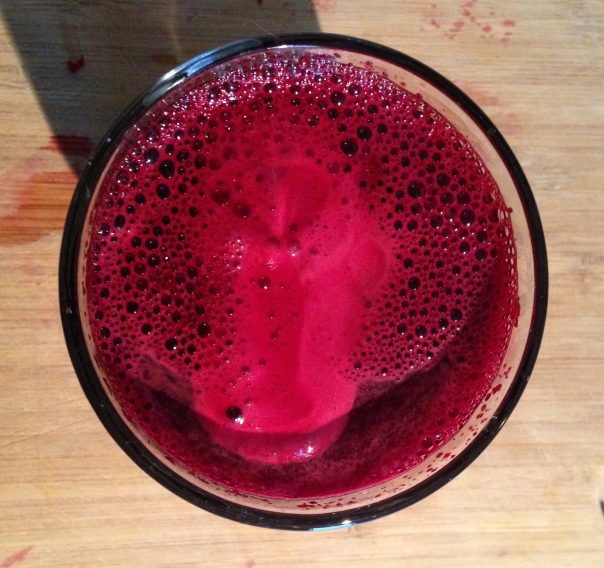
Enjoy!
References:
Velmurugan, S., Gan, J. M., Rathod, K. S., Khambata, R. S., Ghosh, S. M., Hartley, A., … & Kuhnle, G. G. (2016). Dietary nitrate improves vascular function in patients with hypercholesterolemia: a randomized, double-blind, placebo-controlled study. The American journal of clinical nutrition, 103(1), 25-38.
Gluten-Free Cinnamon French Toast Muffins
I was browsing around a bunch of food blogs and websites one night, and I came across a Cinnamon French Toast Muffin recipe. It looked glorious! I had to try it out.
I decided to make a gluten-free version of it for work, and they turned out delicious! The chunks of french toast baked into the top of the muffin make it not your average muffin. They’re nice and toasted on the french toast tops, and then with the maple and cinnamon sugar topping… to die for! It puts you right into breakfast mode, and I LOVE breakfast, its definitely my favourite meal of the day hands down.
It’s the muffin version of this classic breakfast staple! Or dare I say… that sugary cereal I had a few times as a kid when I could somehow convince my mom to buy it! Ah… I’ll stop right there and leave those cereals alone as far as the lack of their nutrition for now. Today is all about these delicious muffins because we all deserve a treat now and then! Here’s the recipe for my Cinnamon French Toast Muffins:
Ingredients
Dry Ingredients:
1 cup brown rice flour
1/2 cup arrowroot flour
1/4 cup chickpea flour
1/4 cup tapioca flour/starch
(Or if you don’t require a gluten-free recipe, use 2 cups of whole wheat flour or spelt flour or a mixture of the two)
2 tsp baking powder
1/2 tsp cinnamon
1/2 tsp salt
Wet Ingredients:
1 egg
3/4 cup packed brown sugar/dark coconut sugar
1/2 cup butter @ room temperature
1 cup unsweetened almond milk
2 tsp vanilla extract
French Toast Topping Ingredients:
5-6 slices of gluten-free (or regular) cinnamon bread, cut into 1/2 inch cubes
1/4 cup almond milk
1 egg
Maple Cinnamon Sugar Topping Ingredients:
1/4 cup maple syrup
2-3 tbsp of raw organic cane sugar/coconut sugar
1/2 tsp cinnamon
Directions
1. Preheat oven to 375°F. In a medium-sized bowl, slightly beat egg and add almond milk. Toss bread in batter and set aside.
2. Combine dry ingredients and set aside.
3. In a separate bowl beat butter, egg and brown sugar until fully combined then combine all other wet ingredients.
4. Slowly add and combine the dry ingredients to the wet ingredients.
5. Line muffin tray with baking cups. Drop muffin batter into cups and fill them about 3/4 full. Then top with the French Toast bread chunks, and push them down slightly into the muffin batter (but leave parts still above surface).
6. Bake for about 15-20 minutes, or until the tops are slightly browned and a toothpick inserted comes out clean.
7. Set out two small bowls, one with maple syrup, the other with the sugar and cinnamon combined. While still warm, dip the tops of the muffins into the maple syrup, then dip and roll in the cinnamon sugar.
Enjoy!
What I made at work April 2
I am lucky to have a fun job where I get to try different desserts every week for the gluten-free kitchen at Fiddleheads in Cambridge, ONT. I am the designated “sweets creator” and I love it!
So I decided to share pictures of my creations with you! Enjoy
Gluten-free Maple Glazed Donuts
Almond Squares
Raw Brownie
The Optimal Sport Drink – ditch that other stuff!
Gatorade – What’s so bad about it?
As a former athlete and now coach, I am really troubled by the mainstream sport drinks out there. Athletes are guzzling them down day after day, and I’m sure never think to read the ingredient list. These drinks have expensive commercials with high profile athletes touting their products, selling them to masses of young athletes but when it really comes down to it, are they really that good for you?
I was curious and so I looked into it. Here are some interesting ingredients:
- Monopotassium Phosphate: used for a source of potassium (which is an electrolyte), and as a preservative. The problem with phosphates is that they cause an imbalance of phosphorus to calcium in the body. Too much phosphorus causes calcium to be drawn out of the blood, and in most cases our bones. Over long-term this can weaken our bones and increase the susceptibility of fractures.
- Brominated Vegetable Oil (BVO): added as an emulsifier, to prevent the flavoring from separating and floating to the surface. It is banned for use in food products in Europe and Japan. Bromines are common endocrine disruptors, it competes for iodine in the body which can affect the thyroid.
- Artificial Colours: these have a wide-range of health risks, and its purpose is only for superficial qualities. Health risks are not on labels in North America. In Europe their labels contain warnings for their associated risks. These include: allergy-like reactions, hyperactivity in children, and carcinogenic effects.
- Dextrose and Sucrose: simple sugars. These provide fuel during a workout. They are refined sugars, stripped of vitamins, and minerals found in natural sweeteners.
So I’ve now come to the conclusion that these are not the ideal drinks, and can be quite harmful especially when drank on a regular basis.
Importance of Hydration for Athletes
Staying hydrated is not only important for athletes but for everyone for various reasons. But here are some specific reasons why, as an athlete, you’ll want to keep sipping your water more.
- Water is the main component of blood. It helps deliver oxygen, nutrients, hormones and other substances to cells and rids them of toxins and waste products.
- Water also has a protective function by cushioning organs and joints from impact or injury, and by helping to regulate body temperature.
- Electrolytes are essential for muscle contractions, regulating fluid in the body, for general nerve function, blood viscosity (and therefore how hard the heart pumps), and for mental clarity.
- Staying hydrated means you can train harder and longer, keep focused, and prevent injury.
Athletes tend to have a low thirst sensation, and extreme temperatures (very hot or very cold) can increase the body’s need for water. When the sensation of thirst is experienced, you have already lost 1.5-2.0 L of fluid! So never wait until you feel thirsty, as you will already be exercising or training in a dehydrated state.
I have made my own version of a sport drink that is free of artificial colours, phosphates, bromines, and refined sweeteners. It is hydrating, full of electrolytes, vitamins and minerals, sweetened naturally at an appropriate ratio for optimal carbohydrate replenishment, AND is cheaper in the long run to make yourself.
This sport drink is meant to be drank during and/or after exercise or training. Depending on how long you train for, and how much water you have lost, you will need to tweak this recipe accordingly. But here is the recipe to make approximately 750 mL of sport drink:
The Optimal Sport Drink
150 mL pure coconut water (no sulphites and no added sweetener)
600 mL water
2 tbsp fresh lemon juice
1 tbsp maple syrup (the real stuff)
1/2 tsp sea salt
Directions: Mix all ingredients together in a bottle or large jug and enjoy! Can keep up to 2-3 days in the fridge.
I gave a cooking class to my ski team a couple weeks ago and they really enjoyed the Optimal Sport Drink!
References:
Brazier, Brendan. Thrive Fitness (2008)
Dr. Mercola: http://www.mercola.com
Environmental Working Group: http://ewg.org
Banana Coconut Muffins (gluten-free & vegan)
I’ve been trying to get this gluten-free baking/science down and its pretty difficult! I had some bananas ripening so I wanted to use them up in a muffin recipe.
I came across this recipe on a gluten-free baking site (http://glutenfreegoddess.blogspot.com/2009/03/big-banana-muffins.html) and made some changes to it. They turned out delicious!
I used coconut sugar and flour in this recipe to increase its nutritional value. Coconut sugar is a natural sweetener from the nectar of the coconut tree. Its nutritional value is almost double that of brown sugar! It is a rich source of potassium, magnesium, zinc and iron.
It is a low glycemic sweetener at levels of only 35 GI (Glycemic Index). This is very low when compared to fruit or refined white sugar, date sugar, maple sugar, honey and molasses at 65 to 100 GI, therefore it will not cause a sharp spike in blood sugar levels.
Coconut Sugar also has a low fructose level of 10% which is a lot lower than the 50% – 90% fructose found in agave nectar products or corn syrup. This is important as your liver can only handle a certain amount of fructose and if consuming too much will convert to fats causing high blood triglycerides and increasing your risk of cardiovascular disease.
Coconut is naturally anti-viral, and anti-bacterial and has been found to reduce LDL blood levels (the “bad” cholesterol), improve blood glucose, reduce insulin levels and boost the immune system. Therefore this is a great alternative for diabetics or those suffering from hypoglycemia.
Preheat your oven to 375 degrees
Add the dry ingredients into the banana mixture and stir until smooth. Note: this batter will be pretty thick!
Spoon batter into greased muffin tray or with muffin cups. On a hard surface, tap the tray down flat to even out the batter. Use the back of a spoon to smooth over the tops of the muffins and to make sure there aren’t any air pockets. Sprinkle with unsweetened shredded coconut. Bake for about 20 minutes, or until a toothpick is inserted into the center and emerges clean.
This is also a great base muffin to add all sorts of other ingredients like: chocolate chips, blueberries, nuts or seeds, or dried fruit.
References:
Mum’s Original Coconut sugar: http://www.mumsoriginal.com/products/?id=18
BALP (Basil, Asparagus, Leek, Potato) Soup
I was inspired after watching Giada De Laurentiis make a beautiful leek, asparagus, basil soup on her cooking show and decided to make a version of it at home!
I added in potato to this beautiful soup to turn it into a little spin on the classic leek and potato soup. Its a great time of year to enjoy soup, and is so quick to make. This is also a great way to feed lots of people on a budget!
Leeks are right at the end of their season so its a great chance to buy them local! Leeks belong in the allium family of vegetables which is closely related to garlic and onions. They’re rich in vitamin K, folate, vitamin C, and vitamin A. Leeks are a wonderful vegetable to add to your diet for its cardiovascular protective benefits – it contains the flavonoid kaempferol, antioxidants, and folate which all contribute to its cardiovascular benefits.
Here’s the recipe for my “BALP” Soup:
3 stalks of leeks, washed* and chopped (see tip below)
1/2 large bunch of asparagus, chopped
5 medium thin-skinned potatoes, skins washed and chopped into 1 inch pieces
1 medium bunch of basil, chopped
5 cloves of garlic, chopped
2 tbsp olive oil
boiled water/vegetable broth
salt and pepper to taste
*leeks have a tendency to get dirt caught in them – slice them in half length wise and run them under water from the bulb to the leaves to remove that hidden dirt.
Directions
1. Put a large kettle of water on or in a medium pot, bring 1 1/2 tetra packs of vegetable broth to a boil.
2. In a large pot on medium to high heat, add olive oil, garlic, salt and pepper. Stir around a bit then add all of your vegetables except basil, and season again with salt and pepper.
3. Add your boiled water or vegetable broth – just until vegetables are covered.
4. Simmer for 15-20 minutes or until potatoes are soft.
5. Remove from heat, add basil, stir around and wait about 2 minutes.
6. Take your hand blender and blend until smooth. Season to taste (if using commercially bought vegetable broth, little if any salt will need to be added).
This recipe makes about 6 servings
References:
The World’s Healthiest Foods – whfoods.org
Peanut butter Crisps (vegan and gluten free!)
I felt like a peanut buttery treat today, so I threw together these crisps in only 10 minutes! You can substitute a lot of the ingredients for whatever you have in your pantry to make them your own. I would have added chocolate chips if I had some around…
Peanut Butter Crisps
1/2 cup rice syrup/honey/agave nectar
1/2 cup natural peanut butter/almond butter
1 tbsp ground cocoa (preferably raw)
1 tbsp coconut oil
1 tsp sea salt
1 tsp vanilla
2 cups of puffed millet/rice crisps
handful of shredded coconut and pumpkin seeds/goji berries/cranberries etc.
Directions
1. In a medium pot on low heat, stir together rice syrup, peanut butter, coconut oil, cocoa and sea salt.
2. Remove from heat and stir in vanilla. Immediately combine puffed millet, shredded coconut and pumpkin seeds.
3. Quickly spread out into square pan lined with parchment paper or roll into balls like I did and enjoy!
These are nice light treats that you can enjoy on the go and share with your family and friends.
How to improve your sleep
Here’s a picture of my puppy Jude – he certainly has no problem getting his Z’s! However, for the rest of us, it’s not always easy getting a good night’s sleep.
A good night’s sleep is such an important factor in health – from weight management, to immunity, sleep can affect so many aspects of your life and health. In order for “good” sleep to occur, we need to keep on specific innate cycles in which certain hormones are released, and repair processes can occur.
18 Way to Improve Your Sleep
- Make your room as dark as possible – you should not be able to see your hand in front of your face. If you must use a digital alarm clock, turn it away from you.
- Keep all electronic devices as far away from your bed as possible – a minimum of 3 ft. This includes cell phones, laptops, digital alarm clocks, and other devices.
- Turn off the TV or remove it from the bedroom.
- Use your bed for sleeping and sex only. Never do work in bed, and avoid engaging in any other activities in bed.
- Keep bedroom neat and clutter-free.
- Choose comfortable, soothing bedding. And if re-painting any time soon, choose relaxing dark earthy tones.
- Keep your bedroom cool, but not cold. The bedroom temperature should not be higher than 21°C. In order to produce and release melatonin, the body needs to cool slightly at night.
- Avoid using a loud alarm clock – waking suddenly to a loud blaring alarm can shock your body and may produce more grogginess if roused in the middle of a sleep cycle as well as affect your mood throughout the day. Try an alarm that starts off at a moderate volume and slowly gets louder. Or a sunrise alarm – it has natural light built in and simulates a sunrise.
- If you go to the bathroom in the middle of the night, keep the lights off. Light shuts down melatonin production.
- Do not sleep with your pets or children in your bed – they can disrupt your sleep.
- Sleep nude or at least with loose-fitting nightclothes.
- Establish regular sleeping hours – try to go to bed and wake up roughly at the same time everyday.
- Go to bed before 11 pm. Your adrenal glands recover every night between 11 pm and 1 am. Start by going to bed every night 15 minutes earlier to work this bedtime into your schedule.
- Sleep 7 to 9 hours a night. Sleeping under 6 and over 9 hours per night has been correlated with higher incidences of cancer. If you are within this range regularly and still do not feel rested in the morning, you may want to get tested for sleep apnea.
- Expose yourself to light first thing in the morning. Open your blinds and turn on the lights – this will put your body into ‘awake’ mode and can help increase your energy levels for the day.
- Keep household lighting dim from dinnertime to bedtime.
- If you drink caffeinated beverages, consume them only in the morning.
- Meditate in the evening.
Irritable Bowel Syndrome – Emotional Connection & Natural Remedies
Thought this comic was pretty cute! Anyways, below you’ll find some useful info about IBS.
IBS – What is it?
It’s a functional gastrointestinal (GI) disorder characterized by some combination of:
- Abdominal pain/distention
- Altered bowel function (constipation/diarrhea)
- Hypersecretion of colonic mucus
- Flatulence, nausea, anorexia
- Anxiety/depression
Who Is it Affecting
It’s estimated that 15% of the population is affected by IBS, and is twice as common in women than men. Its also the most common disorder of the GI system – 30-50% of all referrals to gastroenterologists.
Diagnosis Is Key
Proper diagnosis is essential in dealing with IBS and should be made by a physician. Other conditions must be ruled out first such as:
- Cancer
- Dysbiosis (overgrowth of bad vs. good bacteria in gut)
- Diverticular disease
- Inflammatory bowel disease
- Candidiasis
- Lactose intolerance
- Laxative abuse
- Malabsorption/Metabolic diseases
- Excessive caffeine or carbonated beverage consumption
Causes
The true cause(s) of IBS are not clear. It is a functional disorder, not a structural one like inflammatory bowel disease or Crohn’s. IBS is related to:
- Mental/emotional factors (anxiety, depression, fatigue, hostile feelings)
- Food allergies/intolerances
- Bacterial overgrowth/infection
Emotional Connection
Studies have not determined whether IBS produces these mental or emotional symptoms or if the IBS is a result of them. More research needs to be done.
But this theory, I believe, is not a far-fetched connection between our digestive system and emotions. Our digestive system and nervous system are in fact deeply connected in a system known as the Enteric Nervous System (ENS), also referred to as the “second brain”. It contains about 100 million neurons all along our GI tract which is more than our spinal cord. The ENS is partially connected to the Autonomic Nervous System (ANS), this is our control system affecting heart rate, digestion, respiration rate, perspiration, etc. Now to further confuse you, this system is again divided into the Parasympathetic (PNS) and Sympathetic Nervous Systems (SNS). And here is where I make the connection – the PNS is the “rest and digest” system while the SNS is the “fight or flight” system.
What’s interesting is that stress, whether that be emotional or physical, turns on the SNS – which explains why stress can trickle down into the ENS and is known to exacerbate IBS symptoms.
Your body unfortunately responds to all stresses the same way: digestion is shut down, blood pressure rises, and our pupils dilate among other things. All of these functions innately prepares us to fight for our lives or run for it. This system is turned on no matter what the situation – if we’re running from a sabre tooth tiger or if we’re cut off in traffic.
Natural Remedies
Of course the number one focus should be stress management: develop a stress-reduction program that works best for you. That may be yoga, meditation, counselling, tai chi, hypnosis, or some other forms of relaxation therapy. Exercise is also helpful for IBS.
Enteric-coated peppermint oil (or other volatile oils) have been shown to be helpful in relieving IBS symptoms by calming GI spasms. Just a warning: a slight burning sensation might be felt upon eliminating – that is just the menthol in the volatile oils producing that sensation.
A Probiotic supplement containing at least 10 billion live bacterial cultures of Lactobacillus acidophilus is also key in re-balancing microflora and in the gut.
Fibre is also key, and should be increased in the diet or supplemented.
References
1. Murray, Michael & Pizzorno, Joseph, Encyclopedia of Natural Medicine
2. http://en.wikipedia.org/wiki/Enteric_nervous_system
Cooking Sprays – Just. Don’t. Use Them.
I’m just gonna go on another rant about a popular food product on the market today… I’ve noticed that a lot of people are buying cooking sprays. So I did a little research, and I’d like to share with you what I’ve found.
These cooking sprays tout “All-natural”, and “fat-free cooking” on its label. But they are sneakily deceiving!
Let’s look at the ingredients of Pam cooking spray: canola oil, grain alcohol from corn, lecithin, propellant.
Canola Oil
Canola oil should not be used for cooking as it is heat-sensitive, goes rancid easily and turns into trans fats at high heats. It is also a genetically modified crop that is sprayed in extremely high amounts since it is genetically modified with roundup and engineered to withstand the pesticide.
Propellant
Yes, this word definitely should concern you when you read the label! The propellant that Pam uses in its cooking spray is called isobutane which is also known as propane. Isobutane is a hydrocarbon gas, and according to Environmental Workers Group is classified as a human toxicant and irritant. It is used in food or as an additive with limited or no toxicity information available. There is nothing “all natural” about propellant.
Sneaky Label Laws
The Nutrition Facts labels on this product has a “recommended serving” of a third of a second or less. This translates to less than half of a gram of fat per serving, allowing the company to label the product as “fat-free” according to the labeling law. This is a shame since most people don’t even go as far to read labels and simply buy it because of its flashy packaging. Now even if they do read the label they would think they are consuming a product with no calories, and no fat. This company shamelessly uses labeling laws to their advantage to make consumers believe that they are actually using an oil that is fat-free, which in fact does not exist. Basically, this product is mostly canola oil that has other additives and chemicals in it to make it into an aerosol spray so you use less of it.
Environmental Consequences
An oft-ignored drawback from the use of these products is the waste contributed by the empty aerosol can.
Build-up On Cookware
On top of all the health reasons not to use cooking sprays, these products also tend to build-up on stones, bakeware, and non-stick pans. So if the health and environmental reasons weren’t enough for you, now your sacrificing your expensive cookware.
The Facts About Fats
There is a huge fear out there about fats. The fact is, fats are an essential part of our daily diet. We need them for energy, hormones, and they are constituents of our cell membranes. When cooking with them, at the end of the day it will not make a big difference if you use half a gram vs. 1 gram in the dish you’re cooking. Of course this is a nutrient that needs to be watched portion-wise, but it’s all about balance in your diet. Using simple oil on its own is definitely better than using a spray that contains chemical toxicants and irritants.
What are the best fats to cook with?
For baking and stir-frying: coconut oil, or ghee (a.k.a clarified butter). They are the least heat sensitive oils, and will not turn into trans fats when heated up like other oils. That being said, they should not be used to deep fry anything. There’s no healthy method of deep frying, there’s also nothing health promoting about deep fried food anyways. Coconut oil has many other benefits for your body – its a kind of fat that your body will metabolize first for energy, increases immunity, and aids digestion.
So step away from the cooking spray, people! Now you know the facts.


